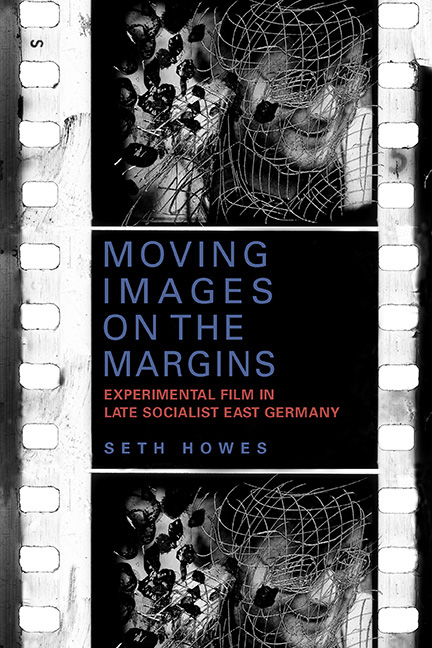Book contents
- Frontmatter
- Dedication
- Contents
- List of Illustrations
- Acknowledgments
- Introduction
- 1 Art, Experimentation, and the Avant-Garde in East Germany
- 2 Heraklesmaschine: Lutz Dammbeck's Experimental Cinema and the Expropriation of the Senses
- 3 Lines of Communication: Mail Art and the Connectivity of Experimental Film
- 4 Herz Horn Haut Schrein: Film and the Autoperforating Body of/at Work
- 5 Film Experiments, Design Anthropology, and the Politics of Vision: Yana Milev's Theory of Practice
- Conclusion: Images of Moving Margins
- Notes
- Bibliography
- Index
4 - Herz Horn Haut Schrein: Film and the Autoperforating Body of/at Work
Published online by Cambridge University Press: 21 March 2020
- Frontmatter
- Dedication
- Contents
- List of Illustrations
- Acknowledgments
- Introduction
- 1 Art, Experimentation, and the Avant-Garde in East Germany
- 2 Heraklesmaschine: Lutz Dammbeck's Experimental Cinema and the Expropriation of the Senses
- 3 Lines of Communication: Mail Art and the Connectivity of Experimental Film
- 4 Herz Horn Haut Schrein: Film and the Autoperforating Body of/at Work
- 5 Film Experiments, Design Anthropology, and the Politics of Vision: Yana Milev's Theory of Practice
- Conclusion: Images of Moving Margins
- Notes
- Bibliography
- Index
Summary
Introduction: The Slaughterhouse at La Villette
FOR THREE DAYS in January of 1990, as the future of the German Democratic Republic remained subject to debate, curious Parisians could encounter art from L’autre Allemagne hors les murs, ‘the other Germany beyond the walls,’ at a major exhibition held in a former slaughterhouse in the 19th arrondissement's Parc de la Villette. Curated by Christoph Tannert, attended by thousands of visitors, and celebrated with a formal reception by French President François Mitterrand, the exhibition included works by some two hundred East German artists. These ranged from easel paintings and sculptures, through appearances by experimental bands and screenings of Super-8 films, to dance performances, fashion shows, round-table discussions, and live actions by artists. Among those performing live were the Autoperforationsartisten, a constellation of Dresden-educated performance artists comprising Micha Brendel, Else Gabriel, Rainer Görß, and Via Lewandowsky. On the first two days Gabriel constructed a seventy-foot umbilical cord out of meat and dough, and Lewandowsky and the poet Durs Grünbein collaborated on a performance entitled Hitlers Ohr rosig im Bunker der Reichskanzlei (Hitler's Ear Rosy in the Bunker of the Reich Chancellery), in which a bandage-obscured Lewandowsky manipulated his armor-plated shins with tools as Grünbein read poems from his cycle ‘Seven Telegrams.’
On the third day, all four Autoperforationsartisten gave a group performance entitled ‘Wir sind wie alle’ (We Are Like Everybody), a title that remarked ironically on the Paris exhibit's imagining of another Germany, defined by its fundamental difference from French (and West German) life. Despite the new setting, in looking back Grünbein assigns the Paris performance a ‘retrospective character,’ insofar as it recapitulated ‘the play of the Autoperforationsartisten over the course of five years. Meat, dough, and blood were manipulated again, M. B. performed his shocking knife-and-meat-mask-dance, while V. L. inserted scissors into his anus, E. G. submerged her hair in a bucket full of blood and, with a chalice of blood, celebrated a sort of agape ritual before running cameras.’3 In this new setting, the butcher's apron Lewandowsky donned during the performance, like the knives grafted to Brendel's hands and the feathers glued to his skin, evoked the Paris exhibition space's original use as an industrial slaughterhouse just as surely as Gabriel's umbilical cord did.
- Type
- Chapter
- Information
- Moving Images on the MarginsExperimental Film in Late Socialist East Germany, pp. 104 - 133Publisher: Boydell & BrewerPrint publication year: 2019



